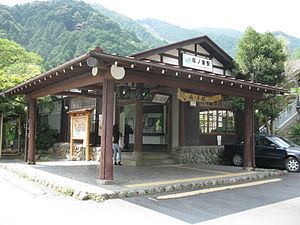Native name 青梅線 Opened 1894 | Type Heavy rail Stations 25 Operator(s) JR East, JR Freight | |
 | ||
The Ōme Line (青梅線, Ōme-sen) is a railway line operated by East Japan Railway Company (JR East) in western Tokyo, Japan. It links Tachikawa and the Chūō Line with the town of Okutama. Many Chūō Line trains operate via the Ōme Line to Ōme Station, providing non-stop service to Tokyo Station.
Contents
Services
Services on the Ōme Line are formed of E233 series trains. Trains from Tachikawa to Ōme typically operate as a 10-car trains (sometimes 4- and 6-car trains coupled together). At Ōme, trains uncouple, with the 4-car set going in the direction of Oku-Tama, and the 6-car set heading back to Tachikawa.
The Ōme Line, at times, runs along the Chūō Rapid, Itsukaichi, and Hachikō lines. Supplemental trains during the peak season may also run along the Nambu Line. Trains that operate only on the Ōme Line have an "Ōme-Itsukaichi Line" sticker on the front.
Holiday Rapid Okutama and Holiday Rapid Akigawa services run on weekends from Shinjuku (and sometimes from Chiba; some Shinjuku-bound services are extended to Tokyo). They are paired together until they reach Haijima. The Okutama stops at Tachikawa, Nishi-Tachikawa, Haijima, Fussa, Ōme, Mitake, and Okutama; the Akigawa splits off from the Ōme Line at Haijima and runs on the Itsukaichi Line tracks to Musashi-Itsukaichi, stopping at every station.
Station list
History
The section between Tachikawa and Ōme was opened in 1894 by the Ōme Railway as a 762 mm (2 ft 6 in) gauge line, extended 2 km as a freight-only section to Hinatawada the following year. Passenger services were extended to Hinatawada in 1898, and the line was converted to 1,067 mm (3 ft 6 in) in 1908. A further freight-only section opened to Miyanohira in 1914, and to Futamatao in 1920. Passenger services were extended to Miyanohira in 1923, the same year the entire line was electrified at 1,200 V DC. The line was further extended to Mitake in 1929, when the company changed its name to the Ōme Electric Railway Co. and the voltage raised to 1,500 V DC in 1930. Passenger services were extended to Mitake in 1935.
The company was nationalized on 1 April 1944, the same year that the Tachikawa to Nagakami section was double-tracked.
The Okutama Electric Railway was constructing a line from Mitake to Hikawa (now Okutama) when it was nationalised, and the line opened on 1 July 1944, creating the present-day Ōme Line.
The Nagakami to Hajima section was double-tracked in 1946, and direct services to Tokyo commenced in 1949. The Hajima to Higashi-Ōme section was double-tracked between 1961 and 1962, CTC signalling was commissioned in 1971, and freight services ceased in 1998.
Former connecting lines
Future developments
In February 2015, JR East announced plans to introduce Green (first class) cars on Chuo Line (Rapid) and through-running Ome Line services from fiscal 2020. This will involve adding two bilevel Green cars to 10-car E233 series EMU sets, forming 12-car sets. Work will be involved in lengthening station platforms and depot facilities to handle the longer trains.
